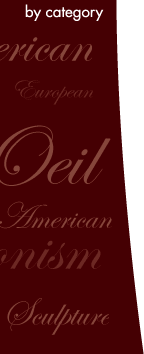
SLOW* ART: A MANIFESTO
A MOVEMENT FOR A CENTURY
New York City - January 11, 2005
We laud the beauty of skills slowly acquired and the deliberate art that reflects such skills.
We believe that the art of the future will be as powerful, relevant, imaginative, and as skillfully made as any art of the past. We reject the notion that art peaked forever in 1500 with the Renaissance, in 1650 with the Baroque, or in 1950 with the Abstract Expressionists.
We value artistic dexterity like that demonstrated by the greatest artists of the past. We believe that the complete mastery of such skills liberate the artist.
We embrace the latest technology, the computer and the Internet, but also applaud new watercolor media that do not fade and paints made by hand.
Like watching a ballet consummately performed, or hearing an aria masterfully sung, we deeply appreciate the visual pleasure of seeing a beautiful work of art that is not found, but slowly and carefully crafted by an artist.
Slow art does not mean the lack of spontaneity or free brushwork. We not only value a delicately painted surface when it is skillfully done as in an Ingres or a Raphael, but we laud the skilled bravura as in a Velazquez or a Turner.
While for some of us subject matter is extremely important, for all of us the pure aesthetic experience is paramount.
While we admire and learn from the great art of the past, our face is to the future. Our aim is not to duplicate the art of the past, nor to denigrate other forms of artistic expression, but to create new artistic standards hitherto unimagined.
*Slow: adj. to proceed without speed
Signed: Graydon Parrish, Jimmy Sanders, Christopher Pugliese, William Kennon, Christiana Inmann, Mikel Glass, Morley Safer,Jane Safer, Paul Brown, Brian le Boeuf, Patricia Watwood, Gregory Hedberg, Laura Grenning, Jacob Collins, Richard Piloco, John Morra, Christopher Forbes, Paul Sullivan, Melinda Sullivan
Witnessed: Kate Lehman, X?, and Lisa Sawitt,
Slow Art: A Manifesto
ADDENDUM - HISTORIC BACKGROUND
PART I : ARTISTS' NIGHTS
This Manifesto was signed on January 11th, 2005, when a group of like-minded artists and collectors gathered together for the eighth Artists’ Night at Margaret and Gregory Hedberg's townhouse in New York City. The purpose of such evenings is to look at new paintings made by the artists present and to critique the work.
The idea for such an Artists’ Night began with The Paint Group formed in New York City by Jacob Collins, John Morra, Mikel Glass, Michael Grimaldi, and Richard Piloco around 1995 that had similar evenings where artists brought in new paintings of their own to be critiqued by colleagues. [In 1999, there was an exhibition of The Paint Group at Hirschl & Adler Galleries organized by Michael Gitlitz, now Director of Marlborough Galleries in New York.] The premise behind such evenings is that even mature artists can further refine their own advanced technical skills and articulate content by means of input from one another.
THE EVOLUTION OF THE MANIFESTO: In the weeks before the previous Artists’ Night at the Hedbergs (November 11, 2004), there had been much discussion amongst the group about a name for their movement and the relevance or need for a short statement of beliefs.
In early November, a draft manifesto entitled Slow Art was e-mailed to the group for comment. The term “Slow Art” was initially viewed negatively by some, as slow is generally considered to be old, yesterday, and dull, and counter to today’s fast pace. One defender pointed out, however, that our inherent prejudice against slowness reflects an old-fashioned, last century thinking.
After the first draft of a Slow Art Manifesto was written, Graydon Parrish discovered Carl Honore’s new book, In Praise of Slowness, published by Harper Collins in 2004. Honore documents a worldwide movement that is challenging the cult of speed. He cites numerous examples of “Slow Movements” in food, music, urban planning, child rearing, sex, and much more. According to Honore, the Slow Food Movement was started by Carlo Petrini in 1986 after McDonald’s opened a branch beside the Spanish Steps in Rome and now the movement boasts 60,000 members worldwide.


3005 Peachtree Road, NE, Suite B
Atlanta, GA 30305